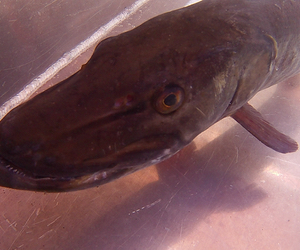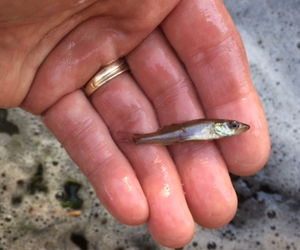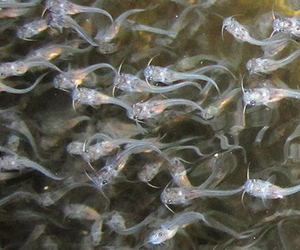FISH HATCHERIES IN ILLINOIS
The Illinois Hatchery System is dedicated to enhancing fish populations in Illinois waters by producing adequate numbers of various species of fish to meet stocking demands statewide. The Fish Illinois Initiative has allowed for increased fish production and added manpower that are essential to maintaining and enhancing the quality of fishing in Illinois' lakes, ponds, reservoirs, and streams. With this initiative, and support from fishing license sales, salmon and trout stamp sales, the Illinois Fish Management Fund and Federal Aid in Sport Fish Restoration dollars, the Illinois hatchery system will continue to stock Illinois waterways well into the 21st century!
FACILITIES
The Illinois hatchery system consists of 3 facilities. Click below to learn more about each hatchery.
HISTORY
The history of fish stocking in Illinois goes back well over 100 years to the very early days of American aquaculture. In the 1870s, just years after the transcontinental railroad was completed, fish were transported to distant bodies of water in train cars. Members of the U.S. Fish Commission (now the US Fish and Wildlife Services) successfully transported juvenile fish cross country in large milk cans. Train passengers were often recruited to assist fisheries workers in adding fresh water to the milk cans to ensure fish survived the trip. The success of these early experiments led many states to try this method, with loads of live fish being transported from coast to coast by the 1880s.
In Illinois, workers would rescue stranded fish from the recently flooded Illinois and Mississippi River bottom lands and distribute them across the state. This led to new fisheries for popular gamefish, such as northern pike and largemouth bass. As hatcheries began to pop up on the West Coast in the late 1800s, aquaculture operations were becoming more refined and making their way into America's heartland. In the field, early ecologists were making crucial observations about native fishes, ones that would shape future fisheries across the country.
One such observation was made by Stephen Alfred Forbes, the first Chief of the Illinois Natural History Survey and a founder of aquatic ecosystem science. Forbes and a team of scientists were studying the Illinois River backwaters in the 1890s when they concluded that a loss of fish in backwaters and sloughs during the recession of floodwaters was a natural phenomenon. To compensate for this loss, captive production of excessive numbers of gamefish species was necessary to produce year-classes that allowed populations to be "maintained at a constant level." In other words, to offset natural die offs, fish production and yearly stockings needed to occur to maintain healthy fish populations. Forbes’ discovery, along with advances in fish rearing techniques and a growing interest in recreational angling, would eventually lead to the construction of Illinois’s first fish hatchery.
In 1914, Spring Grove Hatchery was constructed. Located in McHenry County near the Fox Chain of Lakes, the hatchery represented a huge step in aquaculture for the state. The facility utilized 7 ponds, with sunfishes and basses being the main species produced. In 1971, it was developed into a salmonid station to help the state meet its Lake Michigan salmon stocking commitments. In 1982, Jake Wolf Memorial Hatchery and its salmon rearing facilities were constructed, changing emphasis at the Spring Grove Hatchery to the collection and incubation of walleye and muskie eggs from the nearby Fox Chain of Lakes. This proud facility was finally retired from service in 2005.
Much has changed in the world of aquaculture in the last century. Rail cars have been replaced by stocking trucks, milk cans replaced by aerated tanks, and volunteer train passengers by trained fisheries staff. Over the last 60 years, Illinois has constructed three additional hatchery facilities to meet the increasing and changing demands of the state's diverse fisheries. Since 1984, Illinois hatcheries have been responsible for stocking over 400 million sportfish into Illinois lakes, rivers and streams. From the early days of train cars and milk cans to modern aquaculture in the Prairie state, the Illinois hatchery system continues to maintain healthy fisheries for angler of all ages to enjoy.
ANGLER BENEFITS
The Illinois Hatchery System plays a major role in improving fishing opportunities and fisheries in Illinois. Specific benefits that Illinois anglers receive include:
- Enhanced salmonid fishing in Lake Michigan
- A fall Catchable Rainbow Trout Program
- Statewide fisheries for trophy fish, including Muskellunge, Northern Pike, Striped Bass and hybrid striped bass
- Increased sportfishing opportunities for Black Crappie, Largemouth Bass, Smallmouth Bass, Sauger and Walleye
- Extensive Channel Catfish stocking
- The addition of a Blue Catfish stocking program
- Increased stocking of public waters statewide
PRODUCTION
Illinois hatcheries utilize a combination of intensive and extensive aquaculture techniques to produce and rear millions of fish each year. State hatcheries also work with other US hatcheries to obtain fish eggs and fry to supplement on-site production for certain species. The statewide distribution of the three hatcheries allows them to complement and supplement each other while giving great latitude in rearing a wide variety of species and aiding in the distribution of fish throughout the state. At full capacity, the system can produce over 50 million fish of 20 species.
SPECIES
The Illinois hatchery system produces 20 species of fish. Click on each species for more information.
- Brown trout
- Chinook Salmon
- Coho Salmon
- Rainbow Trout
- Steelhead






